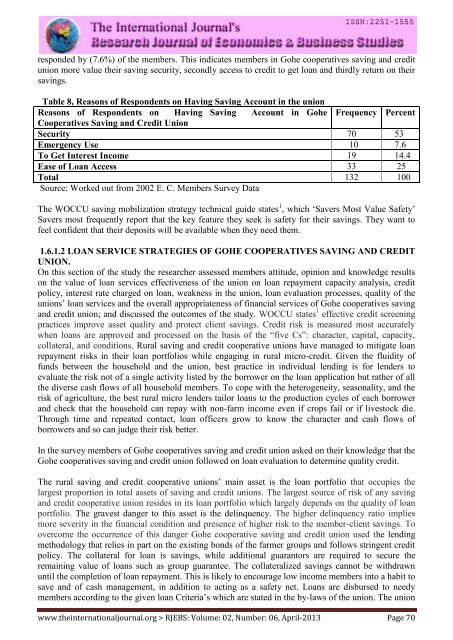Research Journal of Economics & Business Studies - RJEBS - The ...
Research Journal of Economics & Business Studies - RJEBS - The ...
Research Journal of Economics & Business Studies - RJEBS - The ...
- No tags were found...
Create successful ePaper yourself
Turn your PDF publications into a flip-book with our unique Google optimized e-Paper software.
esponded by (7.6%) <strong>of</strong> the members. This indicates members in Gohe cooperatives saving and credit<br />
union more value their saving security, secondly access to credit to get loan and thirdly return on their<br />
savings.<br />
Table 8, Reasons <strong>of</strong> Respondents on Having Saving Account in the union<br />
Reasons <strong>of</strong> Respondents on Having Saving Account in Gohe Frequency Percent<br />
Cooperatives Saving and Credit Union<br />
Security 70 53<br />
Emergency Use 10 7.6<br />
To Get Interest Income 19 14.4<br />
Ease <strong>of</strong> Loan Access 33 25<br />
Total 132 100<br />
Source: Worked out from 2002 E. C. Members Survey Data<br />
<strong>The</strong> WOCCU saving mobilization strategy technical guide states 1 , which ‘Savers Most Value Safety’<br />
Savers most frequently report that the key feature they seek is safety for their savings. <strong>The</strong>y want to<br />
feel confident that their deposits will be available when they need them.<br />
1.6.1.2 LOAN SERVICE STRATEGIES OF GOHE COOPERATIVES SAVING AND CREDIT<br />
UNION.<br />
On this section <strong>of</strong> the study the researcher assessed members attitude, opinion and knowledge results<br />
on the value <strong>of</strong> loan services effectiveness <strong>of</strong> the union on loan repayment capacity analysis, credit<br />
policy, interest rate charged on loan, weakness in the union, loan evaluation processes, quality <strong>of</strong> the<br />
unions’ loan services and the overall appropriateness <strong>of</strong> financial services <strong>of</strong> Gohe cooperatives saving<br />
and credit union; and discussed the outcomes <strong>of</strong> the study. WOCCU states 1 effective credit screening<br />
practices improve asset quality and protect client savings. Credit risk is measured most accurately<br />
when loans are approved and processed on the basis <strong>of</strong> the “five Cs”: character, capital, capacity,<br />
collateral, and conditions. Rural saving and credit cooperative unions have managed to mitigate loan<br />
repayment risks in their loan portfolios while engaging in rural micro-credit. Given the fluidity <strong>of</strong><br />
funds between the household and the union, best practice in individual lending is for lenders to<br />
evaluate the risk not <strong>of</strong> a single activity listed by the borrower on the loan application but rather <strong>of</strong> all<br />
the diverse cash flows <strong>of</strong> all household members. To cope with the heterogeneity, seasonality, and the<br />
risk <strong>of</strong> agriculture, the best rural micro lenders tailor loans to the production cycles <strong>of</strong> each borrower<br />
and check that the household can repay with non-farm income even if crops fail or if livestock die.<br />
Through time and repeated contact, loan <strong>of</strong>ficers grow to know the character and cash flows <strong>of</strong><br />
borrowers and so can judge their risk better.<br />
In the survey members <strong>of</strong> Gohe cooperatives saving and credit union asked on their knowledge that the<br />
Gohe cooperatives saving and credit union followed on loan evaluation to determine quality credit.<br />
<strong>The</strong> rural saving and credit cooperative unions’ main asset is the loan portfolio that occupies the<br />
largest proportion in total assets <strong>of</strong> saving and credit unions. <strong>The</strong> largest source <strong>of</strong> risk <strong>of</strong> any saving<br />
and credit cooperative union resides in its loan portfolio which largely depends on the quality <strong>of</strong> loan<br />
portfolio. <strong>The</strong> gravest danger to this asset is the delinquency. <strong>The</strong> higher delinquency ratio implies<br />
more severity in the financial condition and presence <strong>of</strong> higher risk to the member-client savings. To<br />
overcome the occurrence <strong>of</strong> this danger Gohe cooperative saving and credit union used the lending<br />
methodology that relies in part on the existing bonds <strong>of</strong> the farmer groups and follows stringent credit<br />
policy. <strong>The</strong> collateral for loan is savings, while additional guarantors are required to secure the<br />
remaining value <strong>of</strong> loans such as group guarantee. <strong>The</strong> collateralized savings cannot be withdrawn<br />
until the completion <strong>of</strong> loan repayment. This is likely to encourage low income members into a habit to<br />
save and <strong>of</strong> cash management, in addition to acting as a safety net. Loans are disbursed to needy<br />
members according to the given loan Criteria’s which are stated in the by-laws <strong>of</strong> the union. <strong>The</strong> union<br />
www.theinternationaljournal.org > <strong>RJEBS</strong>: Volume: 02, Number: 06, April-2013 Page 70

















